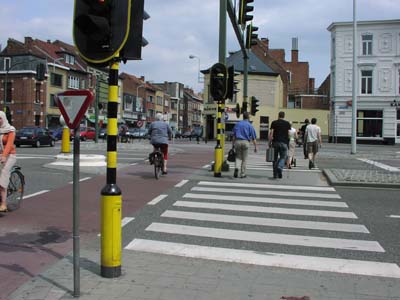

  |
Back to Jennifer Dill's main page
In July 2003 I spent two weeks in London, Paris, and Lueven, Belgium.
Here are some transportation-related pictures
from that trip.
Please do not use without permission.
Link to London's Congestion Charging page
These cameras (top of the poll) monitor compliance with London's congestion charge. Taxis are exempt. "At midnight, images of all of the vehicles that have been in the congestion charging zone are checked against the vehicle registration numbers of vehicles which have paid their congestion charge for that day. The computer keeps the registration numbers of vehicles that should have paid but not done so. A Penalty Charge Notice will be issued to the registered keeper of the vehicle." http://www.cclondon.com/paymentsandpenalties.shtml |
|
 |
This sign and the pavement marking indicates the start of the congestion charging zone. This is near Victoria Station. Here is a map of the zone: |
Bicycling in London & Paris |
|
 |
Bikes are allowed in this bus lane in London. |
 |
An example of bikes allowed in a bus lane in Paris. |
 |
Another example of bikes allowed in a bus lane in Paris. Other cities that allow bikes in bus lanes: This is not a comprehensive list. |
| This one-way street has a striped bike lane in the other direction. I believe it's Ebury Street. | |
| This is the same lane at the intersection. Note the different pavement textures at the pedestrian crossing and the "Look Left" signs on the street. The one you can't see in the bottom left says "Look Right" for the cyclists coming from the opposite direction. | |
| This shows a cyclist entering the reverse direction lane. The blue circle signs indicate the bike lane. | |
 |
At this signalized pedestrian crossing, bikes are allowed to wait in front of the cars in the "bike box." An FHWA report evaluating bike boxes A link to the City of Vancouver, BC brochure on how bike boxes work |
 |
Note how narrow this bike lane is. In Oregon, the standard width of a bike lane is 6 feet. Lanes can be four feet on uncurbed shoulder when there are severe constraints. |
Bicycling in Leuven, Belgium |
|
 |
Leuven is a college town of about 90,000 people. There is parking for over 1,000 bikes at the main train station. This site is going to be developed, and the bike parking will go underground. |
 |
Cyclists can pay for indoor parking at the train station (left), or use the free parking (above). |
 |
At this intersection in Leuven bike lanes are separate from pedestrians in the red paving. |
 |
Left: This one-way street in a town outside of Brussels allows bikes in both directions. Note the sign indicating that people and children may be present. Below: Another example of a street in a town near Brussels with limited car access and full bike access. |
 |
This bike lane in Leuven is painted red. |
 |
These bike lanes in Leuven are between the sidewalk and the area for parked cars.
|
 |
This red bike lane is brick. |
 |
Bike lanes are clearly marked at intersections in Leuven. Some intersections have bike signals (below).
|